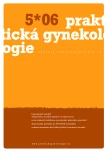Hyperaktivní měchýř: diagnostika, sociální aspekty a kvalita života
Authors:
prim. MUDr. Jan Zmrhal; Csc 1; MUDr. Lukáš Horčička 2
Authors‘ workplace:
Gynekologicko-porodnické oddělení NsP Mělník
Gynekologicko-porodnická klinika 3. LF UK, Praha
1; urogynekologická ambulance GONA, Praha
2
Published in:
Prakt Gyn 2006; 10(5): 174-179
Overview
The overactive bladder as a most frequent cause of chronical diseases and disturbances of the quality of life is evaluated, including cost effectiveness of healthcare systems in developed countries. The overview of initial, basic, and special urogynecological diagnostic was presented. Serious tumors of the bladder, neurological and metabolic diseases with the similar symptoms, as the hyperactive bladder has, are mentioned in the differential diagnostic. The special attention is devoted to the problems of female patients in elderly, where the necessity of special care and individual diagnostic approach is emphasized. There were even specified social aspects of the overactive bladder. The approach of community in the medical care of the incontinent women was mentioned generally.
Key words:
overactive bladder – urge incontinence – differential diagnostics –overactive bladder in elderly - social aspects- quality of life
Sources
1. Abrams P, Cardozo L, Fall M et al. The standardisation of terminology of lower urinary tract function: report from the Standardisation Sub-committee of the International Continence Society. Neurol Urodyn 2002; 21(2): 167-178.
2. Milsom I, Abrams P, Cardozo L et al. How widespread are the symptoms of an overactive bladder and how are they manager? A population-based prevalence study. Urol Int 2001; 87: 760-766.
3. Chapple CR et al. Solifenacin – a new therapeutic option of OAB ? Kongres České urologické společnosti, Praha, říjen 2005.
4. Zmrhal J. Diagnostika v urogynekologii. Celostátní konference České gynekologicko-porodnické společnosti, Hradec Králové, květen 2005.
5. Thűroff JW, Abrams P, Artibani W et al. Clinical guidelines for the management of incontinence. In: Abrams P, Khoury S, Wein A (eds). Incontinence. Plymouth: Health Publications 1999: 933-943.
6. Martan A et al. Inkontinence moči a ultrazvukové vyšetření dolního močového ústrojí u žen. Praha: PanMed 2001.
7. Zmrhal J et al. Místo a význam urodynamických metod v současnosti. Moderní gynekologie a porodnictví 2003; 12(1): 56-70.
8. Zmrhal J. Základy diagnostiky v urogynekologii. Urol L 204; 2(1): 5-13.
9. Jackson S, Donova J, Brookes S et al. The Bristol Female Košer Urinary Tract Symptoms Questionnaire: development and psychometric trstiny. Br J Urol 1996; 77: 805-812.
10. Huvar I. Kvalita života při močové inkontinenci. Prakt G 203; 7(1): 18-22.
11. Otčenášek M. Současné možnosti využití magnetické rezonance v urogynekologii. Postgraduální medicina 2003, 5(8): 878-880.
12. Tomolová Z, Zmrhal J, Voženílek J. Nálezy závažných patologií urotelu u pacientek s OAB ve vlastním materiálu. Praktická urogynekologie, XIV. celostátní konference Urogynekologické společnosti ČR, Mělník, prosinec 2005.
13. Zmrhal J, Horčička L, Lochman P. Dynamische Tests des urethralen Verschluβ-mechanismus und Beckenbodens. Zentrabl Gynäkol 2001; 123: 158-161.
14. Nitti VW, Combs AJ. Correlation of Valsalva leak – point pressure with subjective degrese of stress urinary incontinence. J Urol l996; 155: 281-283.
15. Sultana CJ. Urethral closure pressure and leak-point pressure in incontinent women. Obstet Gynecol 1995; 85: 704-706.
16. Zmrhal J, Topinková E. Inkontinence moči u žen vyššího věku, diagnostika a léčebné možnosti. Postgraduální medicína, příloha Geriatrie pro praktické lékaře 2004; 6(3): 47-56.
17. Pastor Z, Horčička L. Sexuální dysfunkce inkontinentních žen. Gynekolog 1998; 7(2): 52-55.
18. Horčička L. Kvalita života žen s močovou inkontinencí. Lékařské listy, příloha ZdN, 2002: 22-24.
19. Chmel R. Epidemiologické aspekty ženské močové inkontinence. Čas Lék Čes 2005; (2): 95-97.
20. Horčička L. Soudobá léčba hyperaktivního detrusoru. Gynekolog 2005; 14(3): 124-126.
21. Chapple CR, Artibani W, Cardozo LD et al. The role of urinary urgency and its measurement in the overactive bladder symptom syndrome: current concepts and future prospects. Brit J Urol Int 2005; 95(3): 335–340.
22. Stewart WF, Van Rooyen JB, Cundiff GW et al. Prevalence and burden of overactive bladder in the United States. World J Urol 2003; 20(6): 327–336.
Labels
Paediatric gynaecology Gynaecology and obstetrics Reproduction medicineArticle was published in
Practical Gynecology

2006 Issue 5
Most read in this issue
- New options for treatment of disturbances of balance of vaginal environment
- Extrauterine pregnancy after IVF/TESE: casuistic
- New aspects in diagnosis and pathophysiology of polycystic ovarian syndrome
- The family Anamnesis as the Risk Factor of the Breast Cancer
